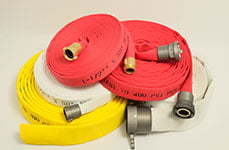
How often are you replacing your fire hoses? A year or two? Less? More?
It’s important to understand the proper care for fire hoses or else you may be very well cutting down on the lifespan of the product(s) you are investing in.
Taking good care of your fire hoses can go a long way in increasing the years you get out of each hose. Taking care of a fire hose the “prescribed” way can lead to a useful life of 10–20 years. More vigorous use will cut down on the lifespan of course, but good fire hose care can still go a long way in keeping your hoses working at maximum efficiency for a longer length of time.
Do:
- Inspect the hose for wear or damage after each use. If you see dirt, you can wash the hose with warm soapy water and a scrub brush, or even simply flush the hose with water.
- Roll and store the hose out of the sun and in a protected area. Too much sun exposure can damage the hose and make it age faster. Definitely keep hoses rolled up in the offseason because animals such as rodents and vermin can cause damages. Also, rolled-up hoses help avoid accidents.
- Let hoses dry, at least a little bit. If the hose is 100 percent polyester, it’s not necessary for the hose to be completely dry because polyester isn’t prone to gathering mold or mildew, which all modern hose is treated to resist. Drying is especially important if the hose is being prepped for seasonal storage, or if the hose will be stored in freezing conditions.
- Store rolled hoses in a secure, flat area.
- Make sure hoses are always in an area you can quickly access, just in case there is an emergency.
- Rotate the positions of your hoses relative to other hoses in the hose lay to lengthen the life of the hose. It’s a similar idea to rotating the tires on your vehicles.
Don’t:
- Use high pressure washers because the lining can separate from the fabric. You can use moderate water pressure to clean the hose.
- Store the hose in a container as hoses need to breathe. That includes the off-season.
- Store near heat sources in the winter or off-seasons.
- Drag hoses. Abrasion and snagging from dragging hoses over rough terrain is one of the top reasons hoses wear out quickly. Woven jacketed hoses (single & double jacket) are particularly prone to this as opposed to rubber covered, lay-flat fire hoses.

